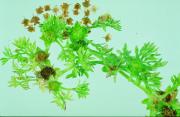This winter-growing annual, originally from South America, produces a seed capsule protected by spines. The seed prickle is very sharp and makes it impossible to walk on a badly infested lawn in bare feet. A closely related species, (Solvia sessilis) has also been found in Perth. Plants first emerge with the winter rains in May and continue to germinate for several months. Flowers begin to appear in spring and continue to form at the base of the leaves (axils) until early December.
Bindii is often confused with carrot weed (Cotula australis), a native plant which at first glance seems similar. However, carrot weed begins to produce flowers during the early part of winter, with pale yellow flowers on the ends of stalks. Bindii flowers much later and has no flower stalks.
Control
Manual removal

If bindii plants are to be removed manually the root needs to be dug up to avoid regrowth. This can be a very tedious process in a badly infested lawn.
It is also difficult to spot all plants in the lawn so manual removal is more likely to be successful with small infestations.
Chemical treatment
The most effective control method for bindii weed is to blanket-spray all the affected lawn with selective herbicides. Effective herbicides contain bromoxynil plus MCPA. Herbicide products are sold in small packs under various trade names, and are available from hardware stores and plant nurseries. These products will also kill many other broadleaved weeds including flatweed (cats ear), dandelion, capeweed, cudweed, and plantain.
Some products also contain dicamba, and one of these should be used if weedy clovers or oxalis species are also present. However, dicamba is not a suitable herbicide for buffalo lawns.
The weeds should be dead 7-10 days after spraying.
For larger areas and commercial applications the same herbicides are sold in large packs from agricultural chemical suppliers.
The concentration of the active herbicide will vary in different products and so the manufacturer’s recommended rates (given on the label) should always be followed.

